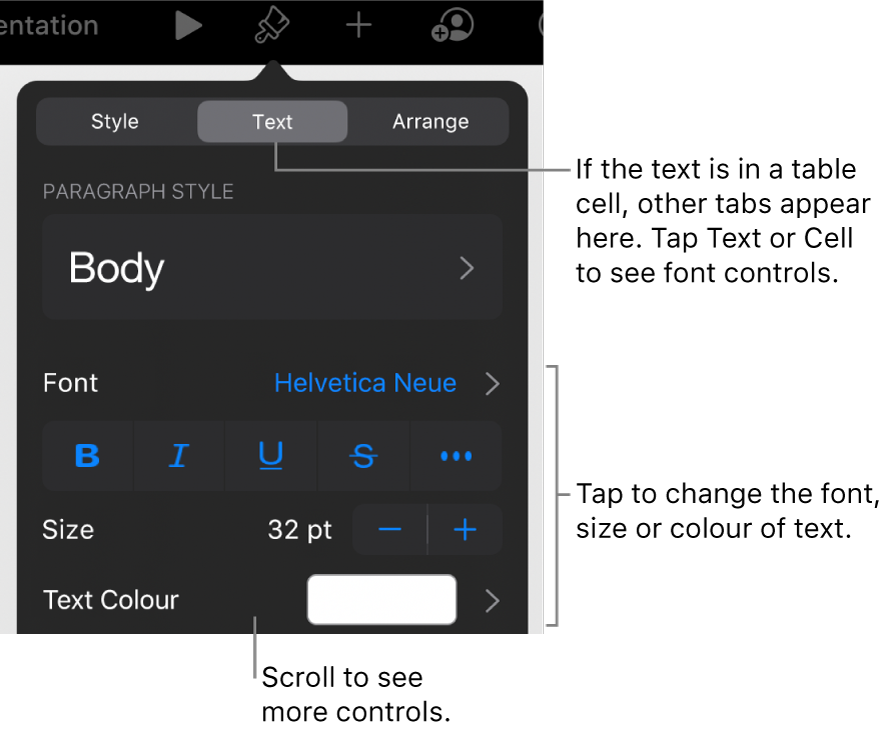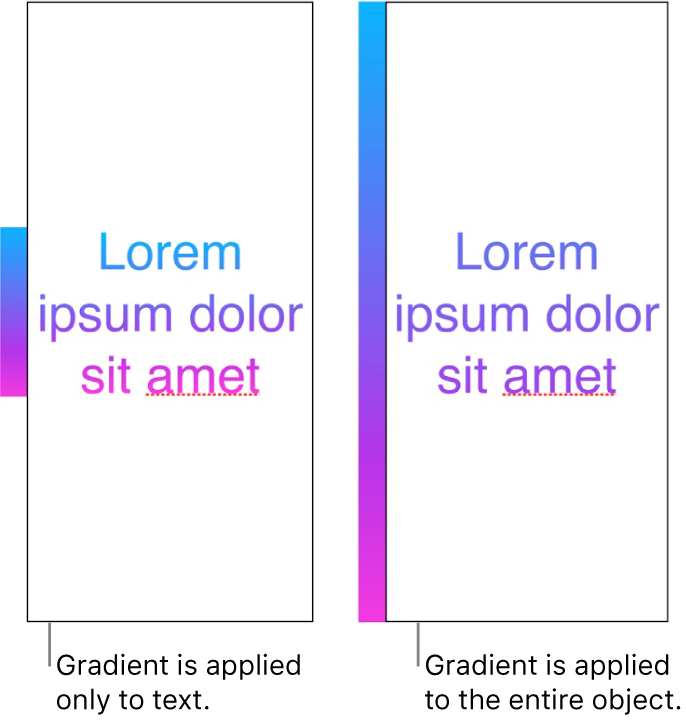
Change the look of text in Keynote on iPad
You can change how text looks by changing its font, size or colour, or by adding bold, italic or other formatting. You can also fill text with gradients or images or add an outline. To highlight text, you can add colour behind it.

Change text appearance
Select the text you want to change — or tap a text box, shape or table cell — then tap
 .
.Tap Cell (for text in a table) or Text (for text in a shape or text box), then do any of the following:
Apply a different paragraph style: Tap the style name below Paragraph Style, then tap a new paragraph style. You can’t apply a paragraph style to text in a table cell.
Change the font: Tap Font, then tap a new font. To see more options for the font (light italic, semi bold and so on), tap
 next to the font name.
next to the font name.Apply bold, italic, underline or strike-through: Tap one of the buttons below Font.
Change the size: Tap any of the buttons next to Size to decrease or increase the font size.

Note: By default, the font size automatically changes to fit inside most text boxes. To manually adjust the font size, select the text box and tap
 , then turn off Shrink Text to Fit at the bottom of the Text menu.
, then turn off Shrink Text to Fit at the bottom of the Text menu.
You can use text formatting buttons in the shortcut bar above the keyboard to quickly add bold, italic or underline to text. These buttons appear on the right of the predictive text fields.
If your keyboard doesn’t show predictive text, you can turn it on in Settings ![]() > General > Keyboard.
> General > Keyboard.
Change the colour of text
Select the text you want to change — or tap a text box, shape or table cell — then tap
 .
.Tap Cell (for text in a table) or Text (for text in a shape or text box) to show the text controls.
Tap Text Colour, then choose one of the following:
A colour or gradient designed to go with the theme: Tap Preset, swipe left or right to see all the choices, then tap a colour.
Any colour: Tap Colour, then tap a colour.
To preview text in different colours, touch and hold a colour, then drag across the grid. A colour label appears for each previewed colour to help you reproduce an exact match. Release your finger to select a colour.
A colour from elsewhere on the slide: Tap Colour, then swipe left to the colour wheel. Tap
 , then tap any colour outside the selected text. To preview colours, touch and hold a colour on the slide, then drag across other colours on the slide. Release your finger to select a colour.
, then tap any colour outside the selected text. To preview colours, touch and hold a colour on the slide, then drag across other colours on the slide. Release your finger to select a colour.A custom colour: Tap Colour, swipe left to the colour wheel, then drag the slider around the wheel. To change colour brightness, drag the top horizontal slider. To change colour saturation, drag the bottom slider. To revert to the previous colour, tap the circle in the centre of the colour wheel (the left half shows the previous colour).
A recently created custom colour or a recently selected colour from elsewhere on the slide: Tap Colour, swipe left to the colour wheel, then tap a colour well to the right of
 .
.A two-colour gradient fill: Tap Gradient, tap Start Colour or End Colour, then tap a colour or swipe left to use the colour wheel. To switch the gradient direction, tap Flip Colour. To change the gradient angle, drag the Angle slider. To apply the gradient based on the length of the shape or text box (not the size of the selected text), select the tick box next to Apply Gradient to Entire Object. The gradient changes when the size of the object or text box changes.

Fill text with an image
Select the text you want to change — or tap a text box, shape or table cell — then tap
 .
.Tap Cell (for text in a table) or Text (for text in a shape or text box) to show the text controls.
Tap Text Colour or Colour, then tap Image.
Tap Change Image, then do one of the following:
Tap an album, then tap a photo.
Tap Take Photo.
Tap “Insert from” to choose an image from iCloud Drive.
If the image doesn’t look the way you expected or you want to change how the image fills the object, tap an option:
Original Size: Places the image inside the text without altering the image’s original dimensions. To resize the image, drag the Scale slider.
Stretch: Resizes the image to fit the text’s dimensions, which might change the image’s proportions.
Tile: Repeats the image inside the text. To resize the image, drag the Scale slider.
Scale to Fill: Makes the image larger or smaller to leave no space in the text.
Scale to Fit: Resizes the image to fit the text’s dimensions, but maintains the image’s proportions. Some text might not be filled.
To create a tinted image, turn on Colour Overlay and tap Fill to select a tint colour.
To make the tint more or less transparent, drag the Opacity slider.
Add or remove a text outline
Select the text you want to change — or tap a text box, shape or table cell — then tap
 .
.Tap Cell (for text in a table) or Text (for text in a shape or text box) to show the text controls.
Tap
 in the Font section of the controls.
in the Font section of the controls.Turn Outline on or off.
If you add an outline, use the controls to change its style, colour and width.
Tip: You can remove the text colour to emphasise the outline. Tap ![]() , tap Text, then tap Text Colour. Tap Preset, swipe to the black and white options, and then tap No Fill.
, tap Text, then tap Text Colour. Tap Preset, swipe to the black and white options, and then tap No Fill.
Add a background colour to text
You can add colour behind any selection of text — individual characters, words or entire paragraphs — to create a highlight effect.
Select the text you want to change — or tap a text box or shape — then tap
 .
.If you don’t see text controls, tap Text.
Tap
 in the Font section of the controls.
in the Font section of the controls.Swipe up, then tap Text Background.
Swipe left or right to see colours (tap Preset or Colours to change the options), then tap one.
For more information about colour options, see “Change the colour of text,” above.
To remove the background colour from selected text, tap Preset, then swipe to the black and white options and tap No Fill.
You can keep text formatting consistent in a presentation by creating and using text styles.